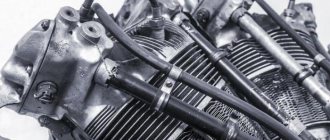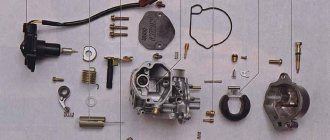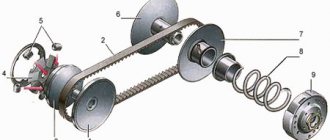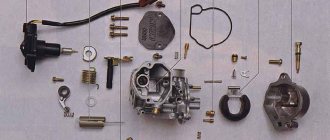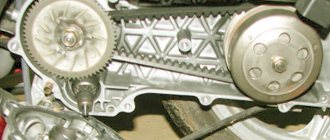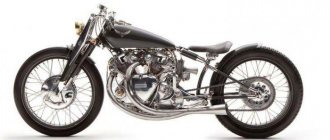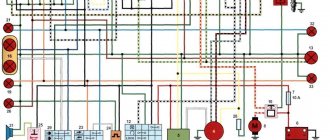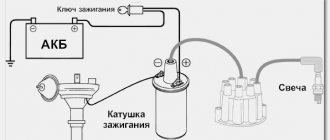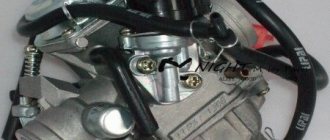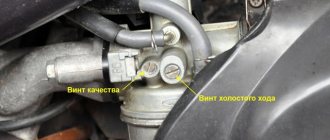Scooter engine - device Scooter carburetor - device, setup Scooter crankshaft Scooter gearbox - device Scooter clutch - device, setup Scooter variator - device Scooter chain drive device Scooter electrics Scooter brake system Switch - electronic ignition of the scooter Scooter speed limiters
Advantages of four-stroke engines
| Advantages of two-stroke engines
|
Types of motorcycle engines
There are two-stroke and four-stroke engines, the operating principles of which are somewhat different.
Also, motorcycles have different numbers of cylinders.
In addition to the original carburetor engine, you can often find injection units. And if motorcyclists are accustomed to fixing the first type on their own, then it is already problematic to repair an injection engine with a direct injection system with your own hands. Diesel motorcycles and even those with an electric motor have been produced for a long time. The article will discuss the characteristics of a carburetor-type motorcycle engine.
Controls
First of all, the controls include the steering wheel, the rotary throttle knob and the control levers. Electrical buttons and switches are also located here. The wheels are equipped with front and rear brakes. In addition, many modern scooters are also equipped with rear-view mirrors, mud guards, lighting and signaling devices.
In this article, we tried to talk as informatively as possible about the main components of a modern scooter. We hope that this article will be useful to you. Tags:
scootersrecommendationsinteresting
Four stroke engine
Such engines have a duty cycle of four piston strokes and two crankshaft revolutions. The engine diagram clearly shows the structure of a piston internal combustion engine and its working process.
- On intake, the piston moves down from top dead center, drawing mixture through the open valve.
- During compression, the piston rising from bottom dead center compresses the mixture.
- During the working stroke, the mixture, ignited by an electric spark plug, burns, and the gases move the piston down.
- When exhausting, the piston, rising, pushes the exhaust gases through the open exhaust valve. When it reaches top dead center again, the exhaust valve closes and the whole process repeats.
The advantages of four strokes are:
- reliability;
- efficiency;
- less harmful exhaust;
- little noise;
- Oil and gasoline are not pre-mixed.
The design of this type can be depicted by the following engine diagram.
Combustion and expansion (piston stroke) - four-stroke engine
Shortly before the end of the compression stroke, the combustible mixture is ignited by a spark from the spark plug. As the piston moves from TDC to BDC, the fuel burns, and under the influence of the heat of the burned fuel, the working mixture expands, pushing the piston. The degree of “under-rotation” of the engine crankshaft to TDC when the mixture is ignited is called the ignition timing angle
. Ignition advance is necessary so that the gas pressure reaches its maximum value when the piston is at TDC. Then the use of energy from burned fuel will be maximum. The fuel combustion rate practically does not change, that is, it takes a fixed time, therefore, in order to achieve maximum engine performance, you need to increase the ignition timing in proportion to the crankshaft speed level. In older engines, this adjustment was made by a mechanical device (centrifugal and vacuum regulator acting on a breaker). More modern engines use electronic ignition timing to adjust the timing.
Two stroke engine
The engine capacity of this type of motorcycle is usually smaller, and the working cycle takes one revolution. In addition, it does not have intake or exhaust valves. This work is performed by the piston itself, which opens and closes the channels and windows on the cylindrical mirror. A crankcase is also used for gas exchange.
The advantages of this engine are:
- with the same cylinder volume, it has a power that is 1.5-1.8 times greater than a four-stroke;
- does not have a camshaft and valve system;
- production is cheaper.
Which scooter is better, two-stroke or four-stroke?
When purchasing a motorcycle, it is important to pay attention to many nuances, including dimensions, suspension features, load capacity, etc. But first of all, the buyer should decide whether to buy a 2 or 4 stroke scooter. The functionality of the equipment depends on this, so it is important to understand the features of each engine.
What is the difference between 2 and 4 stroke engines?
Many buyers mistakenly believe that the more strokes a scooter engine has, the better. However, this is a misconception that will cost the novice rider a pretty penny.
Two and four stroke engines differ:
Each type of motor has its own advantages and disadvantages. And to decide which scooter is better, a two-stroke or a four-stroke, you need to understand the features of the engines.
Operating principle of 2 and 4 stroke engines
When purchasing a motorcycle, it is important to pay attention to many nuances, including dimensions, suspension features, load capacity, etc. But first of all, the buyer should decide whether to buy a 2 or 4 stroke scooter. The functionality of the equipment depends on this, so it is important to understand the features of each engine.
What is the difference between 2 and 4 stroke engines?
Many buyers mistakenly believe that the more strokes a scooter engine has, the better. However, this is a misconception that will cost the novice rider a pretty penny.
Two and four stroke engines differ:
Each type of motor has its own advantages and disadvantages. And to decide which scooter is better, a two-stroke or a four-stroke, you need to understand the features of the engines.
Operating principle of 2 and 4 stroke engines
First of , buyers pay attention to the price of the equipment. Naturally, devices with a two-stroke internal combustion engine are slightly more expensive than four-stroke models. But this difference is fully compensated by the efficiency and reliability of 4-stroke scooters.
For example, you can buy a good used scooter with a two-stroke engine for 7-10 thousand UAH. A similar used device with a four-stroke “heart” will cost the buyer 11-14 thousand UAH.
Which engine is more powerful?
It is believed that a 2-stroke engine is much more powerful than its four-stroke counterpart. And this is partly true. Since a two-stroke engine gets rid of exhaust gases worse and requires additional purging, its power exceeds a four-stroke engine by only 1.5 times.
However, devices with a 2-stroke power unit are noticeably inferior to their counterparts in dynamics. This means that a scooter with a weaker four-stroke engine performs better at the start, picks up speed confidently and maintains speed well.
On the other hand, two-stroke machines perform well at peak power. But this significantly increases wear on the power unit.
Comparison of two-stroke and four-stroke scooters
One of the key parameters for motorcycles is reliability. And the highest service life is for devices with a four-stroke engine. The reason for this is the efficient oil supply system. Roughly speaking, every part of the power unit literally “floats” in liquid, which significantly reduces component wear.
Cylinders and the work process in them
The working process of one and the other engine occurs in the cylinder.
The piston here moves along a cylindrical mirror or insert sleeve. If air cooling is used, then the cylindrical jackets have ribs, and with water cooling they have internal cavities.
The crankshaft, through the connecting rod, perceives the movement of the piston, transforming it into rotation, and then transmitting torque to the transmission. It also powers the gas distribution mechanism, pump, generator and balance shafts. The crankshaft has one or more elbows depending on the number of cylinders.
In a four-stroke engine, in order to better fill the cylinder with the mixture, the intake begins before the piston reaches top dead center, and ends after it passes bottom dead center.
Its cleaning begins even before reaching bottom dead center, and exhaust gases are pushed out as the piston moves to top dead center. The exhaust valve then closes to allow the gases to leave the cylinder.
The following types of gas distribution mechanism are used on this type of engine:
- OHV;
- OHC;
- DOHC.
The latter type has a minimal number of elements, so the crankshaft can rotate faster. Therefore, DOHC is becoming increasingly common.
Four-stroke engines have a more complex design compared to two-stroke engines, as they have a lubrication system and a gas distribution mechanism that two-stroke engines do not have. However, they have become widespread due to their cost-effectiveness and less harmful impact on the environment.
Motorcycle engines are most often one-, two-, and four-cylinder. But there are also units with three, six and ten cylinders. The cylinders are in-line - longitudinal or transverse, horizontally opposed, V-shaped and L-shaped. These motorcycles usually have an engine displacement of no more than one and a half thousand cubic meters. Engine power is from one hundred fifty to one hundred eighty horsepower.
World of scooters.
Models, selection, tuning, repair and driving. >> Design and principles of operation. Engine. Contents :: Next >>
Design and principles of operation
All types of scooters can be divided into two classes - with two-stroke and four-stroke engines. The design and operating features of all systems are also determined by the type of engine.
Piston internal combustion engine: 1 - cylinder head; 2 - cylinder; 3 - piston; 4 — connecting rod; 5 - crankshaft; 6 - crankcase; 7 - spark plug. Combustion chamber volume Total volume Working volume Piston stroke TDC BDC.
Principles of operation of internal combustion engines
A mixture of fuel and air, also known as the combustible or working mixture, prepared in the carburetor, is sucked into the engine cylinders, then compressed by the piston and ignited by an electric spark from the spark plug. When the mixture burns, the expanding gases press with great force on the piston located in the cylinder. The reciprocating motion of the piston is converted into rotation of the crankshaft through a crank mechanism. The flywheel, attached to the end of the crankshaft, smoothes out the unevenness of its rotation and accumulates the kinetic energy necessary for the movement of the piston in the cylinder during non-working strokes. The extreme positions of the piston moving in the cylinder are called dead centers - top dead center (TDC) and bottom dead center (BDC). The distance from TDC to BDC is called the piston stroke, and the space created is called the cylinder displacement. The total internal volume of the cylinder is the sum of the working volume and the volume of the combustion chamber above the piston. The ratio of the total volume to the volume of the combustion chamber is called the compression ratio; the higher it is, the more efficient the engine's operating process is. Modern scooter engines have a compression ratio of 8.5-10 units. Scooter engines are divided according to the method of operation into two-stroke and four-stroke, and both types have both advantages and disadvantages. A two-stroke engine is structurally simpler than a four-stroke engine, since it does not have a valve control mechanism and a pressure lubrication system.
Scooters are equipped with internal combustion engines (ICE), in the cylinders of which the thermal energy of the burning fuel-air mixture is converted into mechanical work. Although many companies are experimenting with other energy sources - electric and fuel cells, it is too early to talk about their widespread use on scooters.
On scooters with large engine displacements, four-stroke engines are more often used due to their advantages in torque flow, greater efficiency and, most importantly, less toxicity.
Working process of a four-stroke engine: a - intake; b - compression; c — expansion (working stroke); g - release; 1 — inlet valve; 2 - spark plug; 3 - exhaust valve.
Four-stroke engines
In these engines, the working cycle occurs in four piston strokes (stroke) and two revolutions of the crankshaft: intake - the piston descends from TDC and sucks in the combustible mixture through the open intake valve; compression - the piston rising from BDC compresses the combustible mixture with the valves closed; working stroke - the mixture burns, ignited by an electric spark, and the resulting gases, expanding, move the piston down (this stroke of the piston is called working, since useful work is done at this time); exhaust - the upward moving piston pushes the exhaust gases through the open exhaust valve.
Two-stroke engines
In two-stroke engines, unlike four-stroke engines, the working cycle occurs in one revolution of the crankshaft. Another feature is the absence of valves (intake and exhaust) with a mechanical drive. Their role is played by the piston itself, opening and closing special windows on the surface of the cylinder. The crankcase volume under the piston is also used for gas exchange. As the piston moves upward from BDC, the volume under the piston increases and a vacuum is created in it. Under its action, the combustible mixture enters the sub-piston space. At the same time, the upward moving piston displaces the exhaust gases remaining from the previous cycle from the cylinder. Simultaneously with the displacement of these gases, the working mixture enters the cylinder, which got here during purging, which will be discussed a little later. As the piston moves upward, it closes the bypass windows on the inner surface of the cylinder, as a result of which compression of the combustible mixture begins in the volume above the piston. At TDC, the mixture in the combustion chamber is ignited by an electric spark. The burning air-fuel mixture expands and pushes the piston down - a working stroke is completed. Having descended approximately 2/3 of its stroke, the upper edge of the piston opens an exhaust port on the surface of the cylinder. Exhaust gases under excess pressure exit through this window into the exhaust pipe. Through other windows, a fresh charge of the combustible mixture enters the cylinder from the crankcase cavity, where the descending piston creates excess pressure. This flow of mixture is called purging, and windows and channels are called purging. Modern two-stroke engines have multi-channel (3-5 channels) return-loop blowing. In addition, a check plate (petal) valve is installed at the inlet of the cylinder, which is controlled by the vacuum in the crankcase. During intake (the piston moves from BDC to TDC), under the influence of vacuum in the sub-piston space, the valve plates open the passage of the combustible mixture from the carburetor. When the piston moves back (during purging), excess pressure in the crankcase presses the valve plates against its body, preventing the mixture from being thrown back from the crankcase into the carburetor.
The working process of a two-stroke engine: a - inlet into the crank chamber, compression in the cylinder; b - ignition (before TDC) and subsequent combustion in the cylinder; c — release of exhaust gases from the cylinder and purging with a combustible mixture from the crankcase; 1 - purge channel; 2 — exhaust channel; 3 - spark plug; 4 — petal valve in the inlet channel; 5 — inlet channel; 6 - crank chamber.
Cylinder
The piston moves along the inner surface of the cylinder, called the cylinder surface. Until recently, scooters used solid cast iron cylinders, although on motorcycles this material was abandoned long ago due to its greater mass and worse heat dissipation than aluminum. In scooters, forced air cooling prevents the cast iron cylinder from overheating, and the deciding factor in favor of using the latter is the lower cost of a solid cast cylinder (aluminum cylinder requires an insert liner). In modern engines, hard-alloy nickel-silicon compositions (“Nikasil”) are applied to the aluminum cylinder base, abandoning the use of steel or cast iron liners. Depending on the type of cooling system adopted, the jacket (outer surface) of the cylinder has fins (for air cooling) or internal cavities for the passage of coolant.
The reed valve improves cylinder filling, increases engine power and efficiency, especially at low and medium crankshaft speeds.
The design of a two-stroke engine ensures that the exhaust gases and the combustible mixture are located separately in the cylinder.
External view of the reed valve.
Piston
This important part of the cylinder-piston group perceives gas pressure during combustion of the working mixture. The piston consists of a bottom, upper and lower parts (head and skirt, respectively) and piston pin fixation bosses. The shape of the bottom can be flat or convex; four-stroke engines often have recesses in the bottom for valves. Two-stroke engines have cutouts in the piston skirt through which the combustible mixture passes, since in these engines the piston controls the gas distribution (intake, scavenging and exhaust). The piston head has thickened walls, where two (less often one) compression rings made of special cast iron or steel are placed in special grooves. These rings seal the gap between the piston and the cylinder bore, and also remove heat from the piston into the cylinder. The bosses serve as a support for the piston pin, they have grooves for circlips and holes for lubricating the pin with oil mist. The skirt directs the movement of the piston.
Piston pin
It pivotally connects the piston to the connecting rod. Typically, a floating pin fit is used in the piston bosses and the upper head of the connecting rod; it is secured against axial movements by spring retaining rings installed in the piston bosses.
Reed valve diagram: 1 - reed valve body; 2 - limiter; 3 - elastic plate.
connecting rod
This part transmits force from the piston to the crankshaft and consists of a rod (I-beam or elliptical section) and heads: upper and lower. Depending on the type of engine and the lubrication system used, the connecting rod heads are made with plain bearings (with bronze bushings or liners) or rolling bearings (roller, needle). When a sliding bearing is used in the lower head, the head itself is detachable.
Crankshaft
Receives force from the piston (via the connecting rod), converts it into rotational motion and then transmits torque to the transmission. In addition, other systems and mechanisms are driven from the crankshaft: gas distribution mechanism (GRM), oil pump, generator, cooling system pump, balance shafts (if provided for by the design). The crankshaft of a single-cylinder engine (and the vast majority of such engines on scooters) has one elbow formed by two cheeks and a connecting rod journal. The ends of the shaft, or journals (also called journals), rest on bearings.
Piston (1), needle bearing (2) and piston pin (3) of a two-stroke engine.
In four-stroke engines, in addition to compression rings, the piston has an oil scraper ring that removes excess oil from the cylinder bore.
Due to the unequal thermal expansion of different parts of the piston, its outer surface is given a complex shape at the factory: barrel-shaped (conical) in height and oval in circumference. Pistons are made from high-quality aluminum alloys with a high silicon content, which can withstand high thermal and mechanical loads, and at the same time have a low expansion coefficient.
Piston and crank mechanism of a two-stroke engine: 1 - crankshaft; 2 - piston; 3 — compression rings; 4 — expander ring of the upper piston ring; 5 — piston pin retaining rings; 6 — piston pin; 7 — connecting rod.
Balancing
Any piston internal combustion engine, and especially a four-stroke single-cylinder, has high uneven operation. This is due to the fact that only one stroke of the piston is working, and the rest - one for a two-stroke engine, and three for a four-stroke engine - require energy expenditure. To improve the smooth operation of the engine, the crankshafts have an external flywheel, massive cheeks and counterweights.
Carter
Most often it is formed in two parts, with a longitudinal parting plane. In four-stroke engines, the crankcase (or sump) is usually a reservoir for oil draining from lubricated parts.
Diagrams of gas distribution mechanisms: a - ONS, b - DOHC: 1 - cam; 2 - pusher; 3 — rocker arm (rocker).
Gas distribution mechanism (GRM)
The periods of time when the intake and exhaust valves are open are called valve timing; they are coordinated with the piston strokes. Gas distribution in four-stroke internal combustion engines is controlled by a camshaft (or camshaft), which rotates twice as slow as the crankshaft. When rotating, the camshaft interacts with its cams with pushers, which directly or through a transmission link (rocker arm, rocker) open the valves (intake and exhaust); their closure occurs under the action of valve springs. To better fill the cylinder with the combustible mixture, the intake begins when the piston has not yet reached TDC. As the piston continues to move from TDC to BDC, it sucks in the combustible mixture through the open intake valve; they complete the intake after passing BDC, when part of the mixture enters the cylinder by inertia.
On modern four-stroke scooter engines, as a rule, two types of timing belts are used: OHC and DOHC. Engines with OHC type timing belts have an “upper” camshaft that acts on the valve tappets through levers (rockers). Modern multi-valve heads with four valves per cylinder often use two camshafts, each with its cams directly acting on the valve lifters (DOHC design). This design has a minimum of reciprocating moving parts. Because of this, the inertia of the valve drive is reduced, which makes it possible to increase the engine crankshaft speed, and hence its power. For normal operation of the valve mechanism, there must always be a thermal gap (0.05-0.15 mm) between the valve stem and its drive. When there is no clearance, the valves do not close tightly, as a result of which they burn and fail. With an increased gap, they do not open completely, which causes knocking and, in addition, power is lost. Many engines of modern scooters have timing belts with hydraulic compensators that automatically maintain the required valve clearances. They are driven by oil from the lubrication system. In engines without such a system, the timing gap is adjusted during maintenance.
Design of the valve drive in the DOHC circuit: 1 - adjusting washer; 2 - pusher; 3 - crackers; 4 - outer spring; 5 - valve.
In modern engines, to reduce vibrations, special balancing shafts are sometimes installed, which are driven by a gear transmission from the crankshaft.
Design features of modern engines
Over the past few years, four-stroke engines have become prevalent in 50cc scooters. Currently, in developed countries, scooters with two-stroke engines have limited use, mostly older models. In the foreseeable future, a complete ban on the production of these engines is expected due to the high toxicity of exhaust gases. The exception is the motors that scooters are equipped with. The engines of these scooters are equipped with a Ditech-Direct power supply and gas distribution system (direct injection of the fuel-air mixture into the combustion chamber and purging of the cylinder with a mixture of air and oil).
Diagram of a camshaft drive by a chain: 1 - chain; 2 — chain damper; 3 — camshaft sprocket; 4 — chain tensioner shoe; 5 - tensioner; 6 — crankshaft sprocket.
The layout of scooter engines is not very diverse. The engines of the vast majority of scooters have one cylinder, except for engines with a displacement above 500 cm3 - two-cylinder in-line and V-shaped designs are used here. Among small-capacity cars, the exception is the Italjet Formula Twin 125 scooter, which has a 114.5 cc two-stroke engine with two cylinders. Considering that in most countries there is a legal limit on the maximum speed of “small” scooters to 50 km/h, many companies install various kinds of limiters (in other words, they “strangle” the motors). Removing factory limiters is one of the areas of scooter tuning, which is discussed in more detail at the end of the publication. Scooters with an engine displacement of more than 50 cm3 do not have such restrictions. Thus, the Suzuki Burgman AN650, with an engine displacement of 638 cm3, has a power of 55 hp. With. at 7000 rpm. Scooter engines, especially large ones, are liquid-cooled, have four-valve cylinder heads with two overhead camshafts, and a fuel injection system. Engines with two-valve heads and carburetors are considered obsolete. To reduce the toxicity of exhaust gases, catalytic converters and a clean air supply system for afterburning toxic compounds are increasingly being installed in the exhaust system.
On an experimental basis, the Honda Julio and Crea Scoopy models are equipped with an Idle-Stop system to automatically turn off the engine if it idles for more than 3 seconds. In this case, the engine is started by turning the gas handle.
Promising two-cylinder four-stroke Piaggio engine.
Cleaning the cylinder from exhaust gases begins when the piston has not yet reached BDC, and there is excess pressure in the cylinder. As the piston moves from BDC to TDC, the piston pushes exhaust gases out of the cylinder through the exhaust valve. The exhaust valve closes after the piston passes TDC to allow some of the exhaust gases to leave the cylinder by inertia. Thus, there is a period of time when both valves are open - this is called "valve overlap". Each four-stroke engine model has its own optimal valve timing, which is determined by the profile of the camshaft cams. The most advanced engines have special devices that make it possible to change the valve timing depending on the crankshaft speed.
Valve timing diagram of a four-stroke engine: 1 - opening of the intake valve; 2 - closing the intake valve; 3 - closing the exhaust valve; 4 — opening of the exhaust valve; angle a - valve overlap. Spark discharge vmt nmt.
Contents :: Next >>
Engine oil
Lubrication is necessary to ensure that excessive friction does not occur between engine parts. It is implemented using motor oils that have a stable structure against high temperatures and low viscosity at low levels. In addition, they do not form carbon deposits and are not aggressive to plastic and rubber parts.
Oils are mineral, semi-synthetic and synthetic. Semi-synthetics and synthetics are more expensive, but these types are preferred more, as they are believed to be healthier for the engine. Different types of oils are used for two-stroke and four-stroke engines. They also differ in the degree of forcing.
Scooters Maintenance and repair
As you know, almost all cars and motorcycles are equipped with four-stroke combustion engines .
Modern technologies make it possible to squeeze out their full potential and use it as efficiently as possible. The trend towards fuel economy brings with it new developments and innovations. Initially, all scooters with a volume of up to 50 cubic centimeters were equipped exclusively with two-stroke engines, and mopeds and scooters, such as the legendary Honda Cub, were equipped with four-stroke engines. There is an explanation for this. The scooter has a continuously variable transmission in the form of a CVT, and the CVT requires constantly high speeds, while the peak power must correspond to the speed of rotation of the crankshaft.
Two-stroke engines are ideally suited for this purpose with minimal calculations.
Mopeds and scooters have two to four gears, with the most efficient engine for such a transmission being a four-stroke. In addition, it is significantly economical and high-torque.
Some time after the invention of the scooter, engineers began to think about introducing a low-power four-stroke engine into milk tanks, and at the same time, they should not be inferior in power to their two-stroke brothers. The goal was also to make them more economical, less noisy and significantly increase reliability.
The use of a four-stroke engine with a volume of up to 50 cm3 on a scooter requires significant investments, and therefore an increase in the cost of products. Since there are more parts, repairs will now cost more, and it will be much more difficult to carry out the repairs yourself. Nevertheless, the milestone has been passed, and almost all modern scooters are equipped with four-stroke engines. The bulk of such equipment comes from China and is slowly beginning to acquire at least some quality of plastic and other parts, but it will take many more years to get closer to Japanese and European technology, and in the end, once such quality is achieved, Chinese scooters will come closer in price to them.
"Wet" and "dry" sump
Four-stroke engines use three methods of oil supply:
- gravity;
- splashing;
- supply under pressure.
Moreover, most of the rubbing pairs are lubricated under pressure from the oil pump. But there are also those that are lubricated by oil mist formed as a result of splashing of the crank mechanism, as well as parts to which oil flows through channels and gutters. In this case, the oil pan serves as a reservoir. In this case it is called “wet”.
Other motorcycles have a “dry” sump system, where one section pumps oil into the tank, and the other supplies it under pressure to the friction points.
In spirit-tactics, lubrication occurs with oil, which is found in fuel vapor. It is pre-mixed with gasoline, or it is supplied to the inlet pipe by a metering pump. This latter type is called the “separate lubrication system.” It is especially common on foreign engines. In Russia, the system is included in the engine of the Izh Planet 5 and ZiD 200 Courier motorcycles.
Features of a 4-stroke engine
In a two-stroke engine, lubrication of the piston and cylinder pins, crankshaft, piston, bearing and compressor rings is carried out by pouring oil into gasoline.
The crankshaft of a 4-stroke engine is located in an oil bath, which is a significant difference. That is why there is no need to mix fuel and add oil. All the car owner needs to do is fill the fuel tank with gasoline. The car owner, therefore, has no need to purchase special oil, without which a two-stroke engine cannot function. In addition, in the presence of a four-stroke engine, the amount of carbon deposits on the piston mirror and on the walls of the muffler is reduced
Another important difference is that in a two-stroke engine, a flammable mixture splashes into the exhaust pipe, which is due to its design
It should be recognized that four-stroke engines also have minor disadvantages. For example, their working moments for regulating the thermal valve clearance are not particularly high-quality.
Liquid cooling system
The option is similar to what is installed on cars. The coolant here is antifreeze, which is low-freezing (from minus forty to minus sixty degrees Celsius) and high-boiling (from one hundred twenty to one hundred and thirty degrees Celsius). In addition, antifreeze achieves an anti-corrosion and lubricating effect. Pure water cannot be used in this capacity.
Overheating of the cooling system can be caused by overload or contamination of the surfaces that dissipate heat. Also, individual elements in it may break, causing liquid to leak out. Therefore, the cooling operation must be constantly monitored.
Scooter engine noise - theory and consequences
Like any other internal combustion engine, a scooter engine is subject to wear and tear. This is a natural process and over time you will inevitably hear extraneous noises in the operation of the scooter’s engine, which one way or another may indicate rapid wear of the engine or transmission components.
The sounds can be different, from hissing to rumbling, from the usual clattering to a loud howl. Let's consider the main ones:
- In a four-stroke engine, the thermal clearances in the valve drive mechanism may have been damaged; in this case, the valves must be adjusted. The gaps must be set to those specified by the manufacturer.
- If your scooter is two-stroke and carbon deposits have formed in the combustion chamber, preventing normal operation of the engine, you hear detonation, the combustion chamber needs to be cleaned. To do this, remove the cylinder head, the cylinder itself, and use a wooden spatula to remove carbon deposits inside the cylinder windows and from the piston bottom. It is not necessary to remove the piston itself, just plug the hole in the crankcase with a small rag. In some cases, when the coking of the combustion chamber is insignificant, fuel additives that are specially produced for these purposes help.
- When the cylinder-piston group wears out, the gap between the piston and cylinder increases. At the same time, a peculiar clattering sound is heard when the piston skirt seems to be dangling in the cylinder. This phenomenon can often be found on Hondas with vertical engines.
- If the elements of the CPG are not tightened enough, you can hear a characteristic hissing and whistling. This is the sound of gases escaping. At the same time, the engine runs unstably and compression drops significantly. To fix this breakdown, you need to tighten all the engine threads and check the integrity of the gaskets. Particular attention should be paid to the condition of the gasket between the cylinder head and the cylinder.
- Wear of crankshaft bearings is one of the most labor-intensive breakdowns. To replace the bearings, you will need to “prick” the engine, and this is beyond the power of an amateur scooter rider. The sound when the bearings wear out cannot be confused with anything - it is a howl when gas is added. The howling can be short-lived, it can appear immediately from the start, or maybe after a few kilometers of travel. If the bearing has shattered, you may hear a characteristic cracking sound when there is strong gas release on the center stand. Worn upper and lower connecting rod heads also produce strange noises when the scooter engine is running. Repair consists only of replacing damaged parts.
- In a four-stroke engine, the valve train drive chain may become loose. At the same time, you will also hear an extraneous clattering sound, which is eliminated by proper chain tension. Perhaps the chain has already worn out, then it needs to be replaced.
Supply system
Gasoline with an octane number of at least 93 is used as fuel for carburetor motorcycles.
Motorcycle engines have a power supply system that includes a fuel tank, valve, filter, air filter and carburetor. Gasoline is located in a tank, which in most cases is installed above the engine in order to flow by gravity into the carburetor. In other cases, it can be supplied using a special pump or vacuum drive. The latter can be found on two-stroke bikes.
The fuel tank has a cap with a special hole where air enters. In many foreign motorcycles, however, air enters through carbon tanks. And some have a lock on the lid.
The fuel valve prevents fuel leakage.
Air enters the carburetor through the air filter. The filter comes in three types.
- In the compact oil type, air enters the center, turns 180 degrees and passes into the filter. At the same time, it is cleaned when the flow turns, where heavy particles settle in the oil. The engine of the Ural and Izh motorcycles is equipped with such a filter. However, other types, paper and foam, are used abroad.
- Paper filters are disposable. They must be changed at every maintenance.
- Foam filters are reusable - they can be washed and re-soaked with oil.
Sports motorcycles with engines of 250 cc and above today have a so-called “direct intake” system, where air is taken in from the front of the fairing, thereby increasing the filling of the cylinders at high speeds.
Factors affecting engine power
Four-stroke cycle 1=top dead center 2=bottom dead center A: intake stroke B: compression stroke C: power stroke D: exhaust stroke
The power of a piston engine depends on the volume of the cylinders, volumetric efficiency, energy losses - gas-dynamic, thermal and mechanical, the degree of compression of the fuel-air mixture, the oxygen content in the air and the rotation speed. Engine power also depends on the throughput of the intake and exhaust strokes, and therefore on their flow sections, the length and configuration of the channels, as well as on the diameters of the valves larger than the intake ones. This is true for any piston engine. The maximum power of the internal combustion engine is achieved at the highest filling of the cylinders. Crankshaft speed is ultimately limited by the strength of the materials and the properties of the lubricant. Valves, pistons and crankshafts experience high dynamic loads. At high engine speeds, physical damage to the piston rings and mechanical contact of the valves with the pistons can occur, which leads to engine destruction. The piston rings vibrate vertically in the piston grooves. These vibrations worsen the seal between the piston and liner, which leads to loss of compression, a drop in power and overall efficiency. If the crankshaft rotates too quickly, the valve springs cannot close the valves quickly enough. This can lead to contact between the pistons and the valves and cause serious damage, which is why high-speed sports engines use valve actuators without return springs. Thus, Daimler-Benz mass-produces engines with desmodromic valve control (with double cams, one opens the valve, the other presses it to the seat), BMW uses electromagnetic valve control. At high speeds, the operating conditions of the lubricant in all friction pairs deteriorate.
Together with the losses to overcome the inertia of the reciprocating moving elements of the CPG, this limits the average speed of the pistons of most production engines to 10 m/s.
Carburetor and its types
This device prepares and doses the air-fuel mixture, which then goes into the cylinder. Modern carburetors come in three types:
- spool valves;
- constant vacuum;
- register.
All domestic engines, as well as the Ural motorcycle engine, have spool carburetors. The only exception is the Ural-Vostok, which has a constant vacuum carburetor.
In a spool-type carburetor, the throttle handle is connected to the spool. By acting on it, the air entering the motor is regulated. A conical needle is connected to the spool and enters the sprayer. When it changes, the mixture becomes richer or leaner. A fuel nozzle is installed on the sprayer. And together all the elements make up the dosing system.
In constant vacuum carburetors, the movement of the throttle handle is transmitted to the throttle valve, which is located closer to the outlet of the carburetor. The air in the chamber above the spool interacts with the carburetor mixing chamber. It turns out that the movement of the spool is controlled by the vacuum in the intake tract.
Register carburetors, which are equipped with many foreign single-cylinder four-stroke engines, such as Honda engines, combine the two previous types. It has two mixing chambers, where in one the spool is driven by the handle, and in the other by the vacuum in the mixing chamber.
Lubrication
Lubrication in both models is also carried out differently. In our case, it is carried out by proportionally mixing gasoline and oil. A 4-stroke engine requires the use of a special expansion tank. it is connected by a system of pipes to a plunger pump. from here the lubricant falls into the inlet pipe. Moreover, its quantity is supplied exactly in the volume that is needed.
Based on the foregoing, we can highlight the following advantages that a two-stroke engine has:
- Greater power with the same displacement;
- Simple device;
- Light weight of the unit.
All this forces designers and developers of modern technology to use this model in their new projects. Who knows, maybe over time the discharge and compression system will undergo changes, bringing the efficiency of the equipment to a new level.
Launch
In order to start a cold engine, a rich mixture is needed. Some carburetors have a float stopper in the chamber for this purpose. When its rod is pressed, the fuel level in the chamber rises sharply to a level above the permissible level. Because of this, fuel begins to flow into the intake manifold. And some of the fuel leaks out. For some time now, however, carburetors have been designed in such a way that vapors do not escape outside. Such designs involve the use of an enrichment mixture, which is an air damper or another fuel channel. It is used instead of a drowner.
Recently, four-stroke motorcycle engines often have an electrically controlled fuel injection system. It consists of an electrically driven fuel pump, a battery, electromagnetic injectors, an electronic control unit, which is connected to various sensors, and a distribution pipeline.
There are also engine control systems where the control of the power supply and ignition systems are combined, which increases the efficiency and at the same time the power of the unit.
The main malfunction of the power system, due to which a motorcycle engine may need to be repaired, is a reduction or even cessation of fuel supply due to a blockage. To avoid this, use a fuel filter. In addition, it is necessary to monitor the condition of the air filter and the tightness of the pipes.
What to choose, a scooter with a 2 or 4 stroke internal combustion engine?
The choice of equipment directly depends on the needs of the rider.
If the buyer needs a compact and easy-to-repair device, then it is worth taking a two-stroke scooter. This technique is perfect for the country house, trips around the city or walks. But if the scooter will be used constantly, then you should choose a four-stroke model. Although such equipment requires special care and is more expensive, its reliability and efficiency mitigates these disadvantages.
vote
Article rating
Exhaust system
The exhaust system consists of a cylindrical exhaust channel, a pipe and a muffler. In two-stroke engines, efficiency and power directly depend on the size and shape of the system parts. Therefore, they use exhaust systems on each cylinder separately. They have a resonator, a pipe and a muffling nozzle.
In four-stroke engines, the exhaust is controlled by valves in the gas distribution system, so resonance does not play a special role in them. In them, usually all pipes are reduced to a single muffler.
On some motorcycles, the exhausts are equipped with catalytic converters that reduce the toxicity of emissions (they are installed, for example, on engines from Honda and other Japanese manufacturers). Such devices were developed as a result of increasingly stringent exhaust gas requirements in the European Union, the USA and Japan. In order to prevent the backflow of mixture from the cylinders at idle and low crankshaft rotation, the exhaust systems of many motorcycles are equipped with special power valves.
Purge problem
The higher the crankshaft speed, the more power. But the design of two-stroke engines has this peculiarity - the faster the piston begins to move, the worse the combustion chamber of the cylinder is purged, since the exhaust gas supply and exhaust windows remain open for a very short time.
Chamber purging is the removal of gases and injection of fuel into the cylinder from the crankcase. Fuel begins to be sucked in and remain in the crankcase as the piston moves upward. Then, when the piston goes down, the inlet port closes and the purge window opens, through which a new portion of fuel is supplied and the gases of the previous spent fuel mixture are expelled (see the figure above, in the middle).
This simple design of a two-stroke engine eliminates the need to install a gas distribution mechanism (GRM), a purge pump, valves and a lubrication unit.
Purging while a two-stroke engine is idling (idling) is carried out differently. During operation at XX, purging is carried out by opening the damper to a small angle. This kind of purging is not of high quality, so at idle speed, as many have probably noticed, the engine of a chainsaw or lawn mower does not work stably. As for a chainsaw, for example, Echo (Echo), then you need to pull the choke halfway.
A single-cylinder two-stroke engine has a contour blower, that is, a slot blower. At the bottom of the cylinder in the wall there is a special slot through which gas distribution occurs. During the compression and power strokes, that is, when the piston is up, the intake and purge ports must be closed.
Contour purge - this pre-piston volume (cylinder under the piston) is a purge pump. This design makes it possible to make engines of the smallest dimensions.
Disassembling the engine 1E41QMB (“chain Chinese”) of the Forsage scooter
This article will show in detail the process of completely disassembling the 1E41QMB engine, popularly nicknamed the “chain Chinese”. “Budget” Chinese two-stroke scooters with different trade names are equipped with this engine. Such scooters are becoming less and less common these days due to their ancient and unreliable design, which in modern realities does not withstand even the slightest criticism...
The engine that we will be disassembling today was worn out to such an extent that it did not even show signs of life, compression was at zero, the drive chain was greatly stretched, the oil had not been changed since the purchase, broken silent blocks, etc. In general, there is enough work with this engine...
It is worth noting that this engine is difficult to repair, so think carefully about whether it is worth undertaking the repair yourself or whether it is better to give it to some professional for repair.
So that the article does not turn out to be too long and tedious, as new material is added to the site, the article will contain links that will lead to a specific page of the site, where the replacement or repair of the unit or device you are interested in will be described in more detail, so for now let’s look at the general a description of the disassembly of this engine and if any component in the engine interests you, then simply follow the required link.
So, the oil is drained, the engine is removed from the frame and placed on the table.
Upon external inspection, several faults were immediately discovered.
Oil leakage from under the kickstarter shaft oil seal and, moreover, the crank turned out to be “welded” to the kickstarter shaft, information about eliminating this malfunction can be found in the article: Repairing the kickstarter of a two-stroke scooter (“chain Chinese”) Forsage
Broken silent blocks, information on replacing them can be found in the article: How to change silent blocks on a scooter
We remove all the cooling casings and the air filter, then the generator; information on removing the generator can be found in the article: How to remove the generator on a scooter
We remove the muffler, you only need to unscrew three nuts, few people know that the muffler of a two-stroke engine must be regularly cleaned of carbon deposits, detailed information on cleaning the muffler can be found in the article: How to clean the muffler on a scooter
After removing the carburetor from the engine, we disassemble it and thoroughly clean and bleed the channels and jets. How to properly clean the carburetor is written in the article: How to properly clean the carburetor of your scooter
Unscrew the four bolts and remove the reed valve.
We unscrew the nuts on the cylinder head and remove it; you will find detailed information about installing a new piston on this engine in the article: The main stages of installing a piston on a two-stroke scooter
We remove the cylinder, there is one difficulty in this work: if you do not plan to change the crankshaft, that is, simply “half” the engine, then it is best to raise the piston to TDC and slightly raise the cylinder so that the piston rings do not come out of it, then close the crank chamber with a rag and then completely remove the cylinder.
In this way, you will protect yourself from debris of piston rings getting into the crank chamber; piston rings sometimes become broken and fall into the crank chamber when the cylinder is removed.
The cylinder mirror is all scratched and has traces of deep wear.
We remove the retaining ring from the piston, then push out the piston pin and remove the piston.
Even with the naked eye you can see how badly the piston is worn out.
We remove the oil pump cover and remove the pump; when removing the oil lines and pump, make sure that no dirt gets into them!
We unscrew the two bolts on the main gear cover and remove the starter; detailed information on repairing the starter can be found in the article: Repair and installation of the starter
We unscrew all the bolts on the main gear cover, tap it evenly along the entire perimeter with a wooden mallet and remove it from the engine.
The drive chain turned out to be very stretched - this is very clearly visible from the way it sagged, whether you like it or not, you will have to change it.
Using a screwdriver inserted under the teeth of the clutch pad, fix the crankshaft journal and unscrew the nut on the clutch drum (right-hand thread).
Remove the kickstarter gear in the place with the washer.
Remove the second washer.
Remove the clutch drum bushing.
Remove the clutch drum along with the chain.
Under the drum, there is another support washer.
Remove the springs using pliers.
Remove the retaining rings along with the washers from the axles of the clutch “pads”.
Remove the clutch “pads” from the platform.
As you can see, the friction lining on one “block” was destroyed.
We insert the paws of the puller into the hole and “pull off” the pad.
We immediately remove the key on the crankshaft journal somewhere away.
We remove the oil lines of the engine's separate lubrication system.
We remove the central stand, to do this: remove the return spring, then unscrew the nut on the axle and then unscrew the axle itself.
Use pliers to clamp the axis of the driven sprocket of the main gear and unscrew the nut.
We take out the sprocket, the sprocket here is on the same axis with the drive gear of the rear gearbox and is rigidly connected to it.
Remove the brake pads of the rear wheel.
We place the engine on some piece of wood so that the rear wheel axle “hangs out” and knock it out with a mallet.
We unscrew all the bolts from the generator side.
Tap the crankcase halves evenly on all sides with a wooden mallet until they are completely separated.
We knock out the crankshaft with a mallet.
Unscrew the locking bracket of the main gear driven sprocket axis bearing.
We are looking for a suitable plate with a hole in the center, insert the axle into the hole and use a nut to press out the bearing; between the plate and the parting plane of the cover you need to put something, for example paper.
Unscrew the locking bracket on the rear wheel axle bearing.
The rear axle bearing of the wheel turned out to be very worn out, so we knock it out without regret, and we do the same with the crankshaft bearings. Using a screwdriver, pry up and remove all the seals from their mounting holes.
Well, we have done a complete disassembly of the engine, now all that remains is to thoroughly clean and wash with gasoline and you can assemble the engine. The assembly of this engine is described in detail in the article: Repair of the 1E41QMB engine (“chain Chinese”) of the Forsage scooter
scooter-mania.ru


